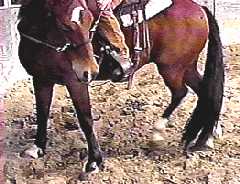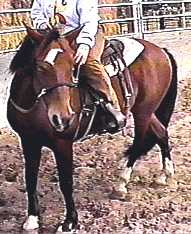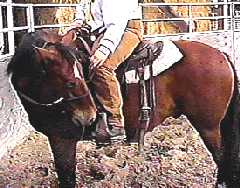"Disengagements and Rollbacks"
| ||||
|
We constantly get requests from people wanting help with a horse that won't stop. The more they pull on the reins, especially with a snaffle bit, the more the horse pulls back. It's simple physics. The horse outweighs the rider and if he wants to pull the rider around, he will. You can either teach the horse to stop by just making it too painful for him to continue (which we don't really consider teaching), or you as a rider can change how you handle the horse, teach him to use his body correctly, and in doing so teach him to get in balance and stop on a simple, light cue. Depending on the horse and how well you execute the cues, he may immediately pick up on what you want and stop on a light rein or he may need a lot of repetition and conditioning (especially if he is a "forwardaholic" horse.) What you want to do is get the horse balanced so that he can stop, teach him some aids so that he understands what it is that you want, and ride him in a position of comfort so that he will want to stay comfortable and light in your hands. Disengagements and rollbacks (also called roll-aways) are two lateral movements which are important for your horse to know. Disengagements can prevent a runaway or bucking situation and the roll-back is a necessary means of turning in narrow confines. Disengagement (often incorreectly described as "circling") stops mindless forward motion and rollbacks teach the horse to get under himself so he can make a good, square stop.
In the disengagement, the horse turns on the forehand. What this means is that the horse pivots on his front feet and makes the turn by stepping around with his hind feet. In order to do this, the horse must step across the outside hind leg with the inside hind leg. If the horse has his legs crossed in this manner, he can't go runaway or buck. Patty Thomas demonstrates the disengagement with "CJ", a BLM "mustang" who was captured as an adult in the wild.
Continue to Part Two; RollbacksPress "Back" to return to the page that brought you hereGo to Case Study SectionReturn to Training SectionReturn to Wild Horse MentorsReturn to KBR World of Wild Horses and BurrosGo To
|

 The left view shows CJ continuing to circle, maintaining position with his front feet and
continuing to cross over in behind.
The left view shows CJ continuing to circle, maintaining position with his front feet and
continuing to cross over in behind.
